Brcc biology 1033 - Study guides, Class notes & Summaries
Looking for the best study guides, study notes and summaries about Brcc biology 1033? On this page you'll find 19 study documents about Brcc biology 1033.
All 19 results
Sort by
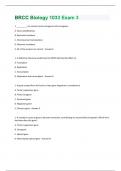
-
BRCC Biology 1033 Exam 3 Questions and Answers(A+ Solution guide)
- Exam (elaborations) • 28 pages • 2024
- Available in package deal
-
- $7.99
- + learn more
1. _________ can convert proto-oncogenes into oncogenes. A. Gene amplifications B. Retroviral insertions C. Chromosomal translocations D. Missense mutations E. All of the answers are correct - Answer-E 1. A defective ribosome would have the MOST detrimental effect on A. Translation B. Replication C. Transcription D. Replication and transcription - Answer-A 1. A gene created from the fusion of two gene fragments is considered a A. Tumor-suppressor gene B. Proto-oncogene C. Structura...
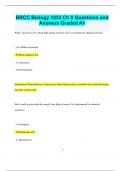
-
BRCC Biology 1033 Ch 8 Questions and Answers Graded A+
- Exam (elaborations) • 9 pages • 2024
- Available in package deal
-
- $9.99
- + learn more
BRCC Biology 1033 Ch 8 Questions and Answers Graded A+ What is the process by which light energy from the sun is converted into chemical energy? - A) Cellular respiration - B) Photosynthesis - C) Glycolysis - D) Fermentation Explanation: Photosynthesis is the process where light energy is converted into chemical energy, typically in plant cells. How would you describe the energy from light in terms of its requirement for chemical reactions? - A) Exergonic - B) Endergon...
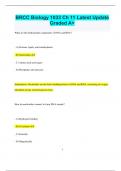
-
BRCC Biology 1033 Ch 11 Latest Update Graded A+
- Exam (elaborations) • 6 pages • 2024
- Available in package deal
-
- $9.99
- + learn more
BRCC Biology 1033 Ch 11 Latest Update Graded A+ What are the fundamental components of DNA and RNA? - A) Proteins, lipids, and carbohydrates - B) Nucleotides - C) Amino acids and sugars - D) Phosphates and enzymes Explanation: Nucleotides are the basic building blocks of DNA and RNA, consisting of a sugar, phosphate group, and nitrogenous base. How do nucleotides connect to form DNA strands? - A) Hydrogen bonding - B) Covalently - C) Ionically - D) Magentically 2 ...
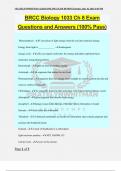
-
BRCC Biology 1033 Ch 8 Exam Questions and Answers (100% Pass)
- Exam (elaborations) • 3 pages • 2024
- Available in package deal
-
- $10.49
- + learn more
BRCC Biology 1033 Ch 8 Exam Questions and Answers (100% Pass)
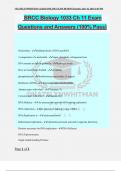
-
BRCC Biology 1033 Ch 11 Exam Questions and Answers (100% Pass)
- Exam (elaborations) • 2 pages • 2024
- Available in package deal
-
- $7.99
- + learn more
BRCC Biology 1033 Ch 11 Exam Questions and Answers (100% Pass)
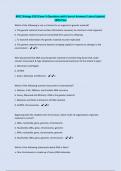
-
BRCC Biology 1033 Exam 3-Questions with Correct Answers/ Latest Update/ 100% Pass
- Exam (elaborations) • 28 pages • 2024
- Available in package deal
-
- $10.49
- + learn more
Which of the following is not a criterion for an organism's genetic material? a. The genetic material must contain information necessary to construct a hole organism b. The genetic material must be transmitted from parent to offspring c. To transmit information the genetic material must be replicated d. The genetic material must be dynamic changing rapidly in response to changes in the environment - ️️D Who discovered that DNA was the genetic material or transforming factor that could...
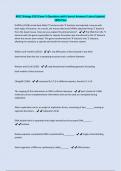
-
BRCC Biology 1033 Exam 3-Questions with Correct Answers/ Latest Update/ 100% Pass
- Exam (elaborations) • 10 pages • 2024
- Available in package deal
-
- $10.49
- + learn more
Griffiths (1928) mixed heat-killed 'S' bacteria with 'R' bacteria and injected a mouse with both types of bacteria. As a result, the mouse died and Griffiths obtained living 'S' bacteria from the dead mouse. How can you explain this phenomenon? -️️The DNA from the 'S' bacteria with the gene responsible for capsule formation was transferred to the 'R' bacteria when the strains were mixed. This gene transformed the 'R' bacteria into 'S' bacteria, allowing it to produce a cap...
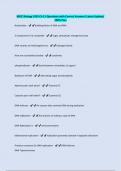
-
BRCC Biology 1033 Ch 11-Questions with Correct Answers/ Latest Update/ 100% Pass
- Exam (elaborations) • 2 pages • 2024
- Available in package deal
-
- $10.99
- + learn more
Nucleotides - ️️building blocks of DNA and RNA 3 components of a nucleotide -️️sugar, phosphate, nitrogenous base DNA strands are held together by - ️️hydrogen bonds How are nucleotides bonded - ️️covalently phosphodiester - ️️bond between nucleotides (2 sugars) Backbone of DNA - ️️alternating sugar and phosphate Adenine pairs with what? - ️️Thymine (T) Cytosine pairs with what? - ️️Guanine (G)

-
Biology 1033 Exam Two Study Guide BRCC questions and answers 2024 with complete solution
- Exam (elaborations) • 10 pages • 2024
- Available in package deal
-
- $7.99
- + learn more
(from the Greek, meaning cell-eating) involves the formation of an enormous membrane vesicle called a phagosome, or phagocytic vacuole, which engulfs a large particle such as a bacterium. *Only certain kinds of cells can carry out phagocytosis. - Phagocytosis 1. What is the difference between potential and kinetic energy? - -Kinetic energy is energy associated with movement, such as the movement of a baseball bat from one location to another. By comparison, potential energy is the energy th...
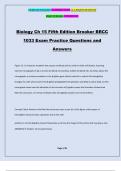
-
Biology Ch 15 Fifth Edition Brooker BRCC 1033 Exam Practice Questions and Answers
- Exam (elaborations) • 16 pages • 2024
- Available in package deal
-
- $12.49
- + learn more
Biology Ch 15 Fifth Edition Brooker BRCC 1033 Exam Practice Questions and Answers Figure 15.1 A missense mutation that causes red blood cells to sickle in sickle cell disease. Scanning electron micrographs of (a) a normal red blood cell and (b) a sickled red blood cell. As shown above the micrographs, a missense mutation in the β-globin gene (which codes for a subunit of hemoglobin) changes the sixth amino acid in the β-globin polypeptide from glutamic acid (Glu) to valine (Val). (c) Thi...

Study stress? For sellers on Stuvia, these are actually golden times. KA-CHING! Earn from your study resources too and start uploading now. Discover all about earning on Stuvia


